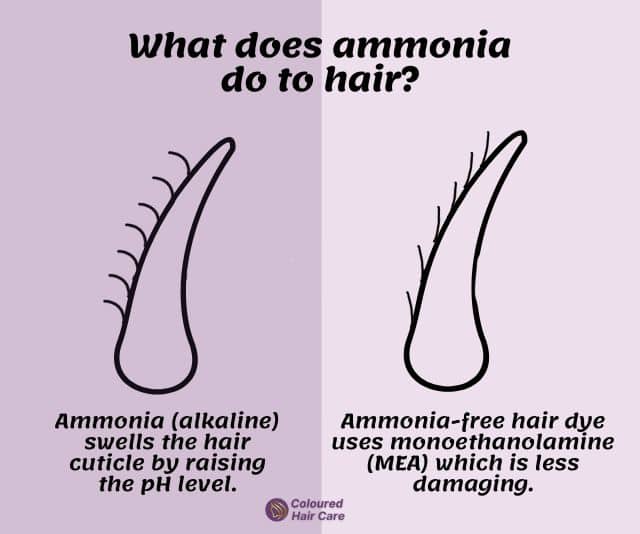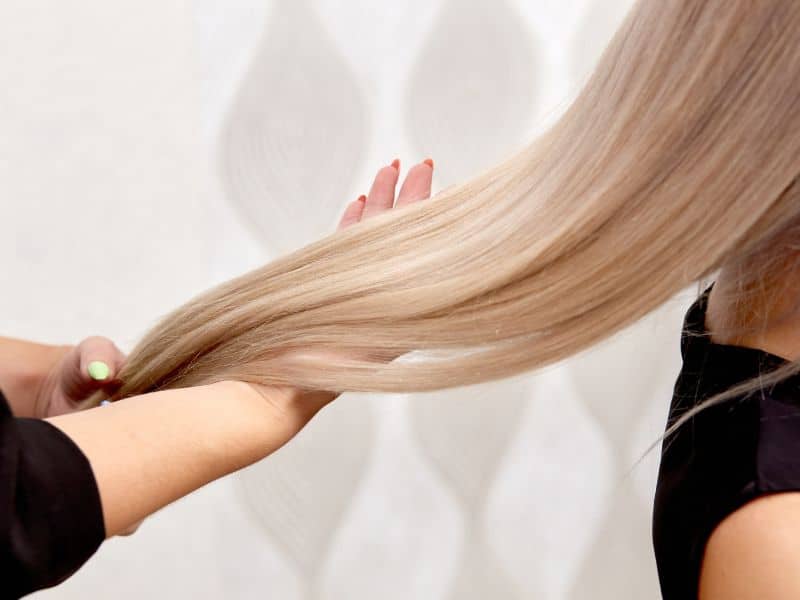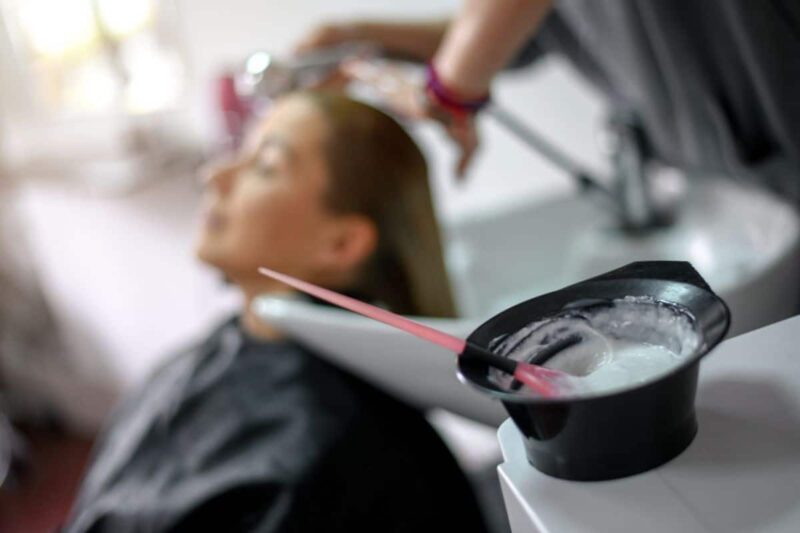We all want gorgeous hair, but we don’t always think about the potential pitfalls of dyeing it. Ammonia is one of the most common components found in hair dyes, and it can cause a lot of damage to your locks!
But no need to worry; there are plenty of ammonia-free options on the market that will give you beautiful color without the harsh chemicals.
Let’s explore what ammonia does to your hair and some top choices for ammonia-free hair dyes too.
Let’s go!
Table of Contents
What is Ammonia?
Ammonia is actually a colorless gas, made of nitrogen and hydrogen, known for its strong scent. It’s a common ingredient in many hair dyes, but why is it there, and what does it do?
Ammonia in Hair Dyes
Ammonia’s job in hair dye is pretty important. It helps open up the outer layer of your hair, known as the cuticle.
This opening action is crucial because it allows the hair dye to penetrate deep into the hair, making the color more effective and long-lasting.
Why It’s Used
According to those hair color experts at Wella, the reason why ammonia is a go-to for hair dyes is its ability to deliver lasting color.
It’s effective in ensuring that the dye bonds well with the hair, giving you that vibrant look for longer. However, its super strong smell and potential impact on hair health have been points of discussion!
A Double-Edged Sword
While ammonia is great for coloring, it’s also known to be harsh with frequent use.
It’s this effectiveness versus hair health consideration that brings ammonia into the spotlight in hair care discussions.

What does Ammonia do to hair?
Ammonia helps to create a longer lasting hair color result, but it can be incredibly damaging to your tresses in a few ways:
Irritation and Dryness
Ammonia can be irritating for those with sensitive skin or scalp conditions.
Unfortunately, recent research by Zoe Diana Draelos, M.D, published in the Journal of Cosmetic Dermatology shows that ammonia can irritate sensitive skin or scalp conditions like eczema or psoriasis if left on too long.
This can lead to redness, itching, irritation, burning sensations, and more. Not exactly a good look!
A study in the International Journal of Research in Dermatology recommends that if you any preexisting conditions that affect your scalp or skin in general (or if you’re just prone to irritation), it might be best to avoid products with ammonia altogether.
Brittleness and Weakness
Ammonia strips away essential oils from your strands.
Recent studies on scalp hair health shows that another downside of using ammonia on your hair is that it strips away all the natural oils in your strands—and those oils are essential for keeping your locks healthy and hydrated!
Without them, you run the risk of having dry and brittle hair over time.
Plus, with all those precious oils gone from your strands and scalp, they become more vulnerable to damage from heat styling tools and other products like gels or waxes.
Long-Term Cuticle Damage
Frequent use of ammonia can lead to long-term damage like split ends.
Without proper nourishment from natural oils or regular trims at the salon (which we highly recommend!), split ends may start appearing—yuck!
Over-processed strands from using ammonia-based products regularly quickly become unmanageable and difficult to style.
The only way to get rid of split ends is by cutting them off completely—so better safe than sorry when it comes to using products with high concentrations of ammonia!
Expert Insights
“Ammonia pulls apart the layer of hair protein so that the dye can access the inner layer of hair, Frequent use of hair dye with ammonia Can cause cuticle damage which makes hair dry, dull, frizzy n brittle n it can lead to many other hair related issues like split ends.”
Tanisha Sharma, Managing Partner, Luxury Unisex Salon
Watch and learn: Is ammonia bad for your hair?
Here’s a great video that tells you simply whether or not ammonia is safe for your hair and some of the risks involved in using it!
Expert Insights
“Non-permanent dyes such as “demi-permanent,” “semi-permanent” and “temporary” colors do not typically contain ammonia. This is why these types of colors tend to fade, because the dye molecules do not fully enter the hair — they basically deposit color on top of the hair shaft.”
Nathan England, Professional Hair Colorist Specializing in Corrective Color

Health and Safety Concerns
When we talk about coloring our hair, it’s not just about the look. It’s also about how safe it is for us and our environment.
Impact on Scalp and Skin
First off, let’s consider our scalp and skin. Ammonia is known for its strong, pungent odor, but it’s not just the smell we need to think about. When it comes into contact with your skin or scalp, ammonia can be quite irritating.
For some of us, this can mean itchiness or discomfort. And for those with sensitive skin, it might even lead to more noticeable allergic reactions like redness or burning sensations. It’s all about how your body reacts to it.
Expert Insights
“If you are sensitive, try a patch test to see how you react to color first. A patch test usually involves dabbing a small amount of the dye solution behind your ear or on your inner elbow and leaving it to dry. If you develop any irritation after the patch test, do not use the product.”
Anne Huijs, Salon Suite Owner
Environmental Concerns
Then there’s the environmental angle. Ammonia doesn’t just disappear after we use it.
When hair products with ammonia are washed away, they can end up in our water systems. This isn’t great news for our environment.
Ammonia can alter the balance in water bodies, potentially affecting plants and aquatic life. So, it’s not just about us, but also about keeping our rivers and oceans healthy.
Expert Insights
“Environmental factors, such as pH and temperature, can affect ammonia toxicity to aquatic animals.”
United States Environment Protection Agency
A Thoughtful Approach
Knowing all this, it’s important to be thoughtful about using hair products with ammonia. It’s not just a matter of picking a color we love; it’s also about being aware of how it affects our health and the environment.
Thankfully, there are alternatives out there that are gentler on both our bodies and the planet.
Alternatives to Ammonia-Based Dyes
Now that we’ve talked about the concerns with ammonia, you might be wondering, “What else can I use?” Good news: there are alternatives to ammonia-based dyes that offer a gentler approach to hair coloring.
Ammonia-Free Dyes: A Gentle Choice
Ammonia-free hair dyes have been gaining popularity, and for good reason. They provide a more gentle way to color your hair, often using alternative ingredients to open the hair cuticle.
This means you can still enjoy a vibrant color but with less risk of irritation to your scalp and skin.
The Ammonia-Free Deep Dive
If you’re curious about these ammonia-free options, our Ammonia-Free Hair Dyes Reviews article has got you covered.
In it we explore the world of ammonia-free hair dyes, the benefits, the top products on the market, and how they compare.
It’s all about giving you the information you need to make the best choice for your hair and health. Check it out!
FAQs on Ammonia and Hair Health
What exactly does ammonia do to the hair?
Ammonia in hair dye works by opening up the cuticle, the outer layer of the hair shaft. This allows the dye to penetrate deeper into the hair for more vibrant and lasting color.
However, this process can also strip natural oils from your hair, leading to dryness and potential damage over time.
Can using ammonia-based hair dyes lead to long-term hair damage?
Yes, frequent use of ammonia-based hair dyes can lead to long-term damage such as dryness, brittleness, and split ends.
This is because ammonia can weaken the hair structure by continually opening the cuticle and stripping natural moisture.
Is it common to have an allergic reaction to ammonia in hair dye?
While not everyone is allergic to ammonia, it can cause irritation and allergic reactions in some individuals.
Symptoms include itching, redness, or a burning sensation on the scalp. It’s advisable to do a patch test if you’re using a product for the first time.
Parting words
So, there you have it – a closer look at ammonia and its role in hair coloring.
We’ve explored how ammonia works to open up hair cuticles for deeper color penetration, but also how it can lead to scalp irritation, dryness, and potential long-term damage to your hair. Plus, we touched on the environmental impact of using ammonia in hair products.
The good news is, there are alternatives. Ammonia-free hair dyes offer a gentler approach to achieving that perfect hair color, minus the harsh effects. They’re a great option for those looking to maintain vibrant hair while also being kinder to their scalp and the environment.
Coloring your hair should be a fun and safe experience. With the right knowledge and products, you can keep your hair looking fabulous without compromising on health and safety. Here’s to happy, healthy hair coloring!
Found your perfect shade? We’d love to see it! Tag us on Instagram @colouredhaircare or Facebook and share your hair dye success stories. Looking for more hair care tips? Check out How to Look After Colored Hair: 11 Expert Secrets For Long-Lasting Color.

Our Research & Review Process
To ensure our recommendations are as comprehensive and reliable as possible, we’ve undertaken an extensive research effort.
We cite scientific evidence and journals, collect real user reviews and gather impartial perspectives from hair stylists, users, and experts in the field.
Additionally, we conduct hands-on testing by using products and applying hair dyes not only on our own locks but also on real human hair extensions and hair pieces of different hair type, textures and lengths.
This rigorous approach allows us to provide you with insights into which products genuinely live up to their promises.
As always – please consult with a professional hair colorist or stylist for advice on how to color your own hair at home. It’s different for everyone!
